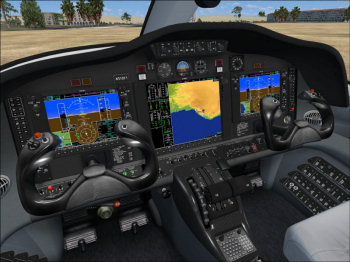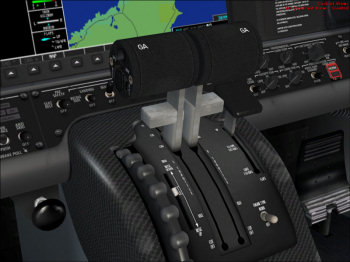Cessna Citation 510 VLJ (FSX)
Flying the Mustang
(Continued)
Another aspect of the Mustang operation that some virtual pilots may be
unfamiliar with is the method of thrust management.
Autothrust is absent in the Mustang; instead the FADEC (Full Authority
Digital Engine Control) provides fixed thrust modes for each phase of flight
- TO (Takeoff) CLB (Climb) and CRU (Cruise). Thrust lever detents are
provided for this purpose; however in the Flight1 add-on the detents are
simply thrust lever positions that advertise their presence on the MFD as a
blue annunciation.
It immediately becomes apparent during taxi that the Mustang requires a
considerable degree of thrust to overcome its inertia, at first this seems
unrealistic, but real world flight tests do confirm that this is indeed a
characteristic of the real world Mustang.
The takeoff run is relatively brisk as you would imagine for a VLJ, but what
you may not be expecting is the extremely low rotation speed of 95 knots,
thanks to the relatively straight high lift wing. This seems strange at
first, to be flying a twin engine jet aircraft at such slow speeds, but it
is entirely in accordance with the real Mustangs capabilities.
Once airborne, gear is raised and pitch is maintained at 10 degrees, until
airspeed increases to around 114 knots, at which point flaps are raised,
thrust levers are pulled back to the CLB detent and autopilot engaged. While
the wing leveller and pitch hold functions do their job, VS Mode (Vertical
Speed) can be engaged, or alternatively pitch can be adjusted with the
autopilot thumb wheel. As the aircraft accelerates to 170 knots FLC
Mode (Flight Level Change) can be engaged, and this is where many flight
simulation enthusiasts may become confused. FLC in the Mustang is not at all
like Flight Level Change in a large jet airliner, it’s actually more akin to
IAS Hold, whereby the autopilot adjusts pitch to maintain a given
airspeed.
As soon as the Mustang levels off at the assigned altitude the thrust levers
are pulled back into the CRU detent, and the autopilot will automatically
maintain the aircrafts best cruise speed with a minimal probability of
over speed. Unlike many turboprop aircraft that use fixed thrust modes for
each phase of flight, the Mustang will not exceed its maximum cruise speed
even at low altitude thanks to the FADEC. However, sudden wind changes can
result in excess speed.
I must confess to originally being somewhat startled by the Mustangs
deceleration. The rapidity in which airspeed seemed to bleed off when the
thrust levers were brought back to idle initially surprised me. However, now
I‘ve had an opportunity to become more familiar with the add-on and it’s
systems, I have no issues in this regard at all and would regard the fairly
rapid deceleration I initially perceived as perfectly valid given the
aircrafts minimal mass and therefore negligible inertia. In addition,
it’s easy to comprehend how the very small jet engines would have little
residual thrust at idle. Another factor in favour of the developer’s
interpretation in this regard is the glide ratio, and I can confirm that
having tested the glide ration in FSX it is indeed as estimated for the
real Mustang.
Final approach will be entertaining if you happen to be a big iron fan, you
will almost certainly be unprepared for the slow approach speeds, deploy the
flaps too early and experience ballooning, however after a few fights you
will quickly become accustomed to approach speeds more akin to a single
engine piston prop, than a business jet.
I have to say, the Mustang is a pleasure
to hand fly, very reminiscent of the Flight1 Pilatus PC-12 in that regard,
and safe slow
speed touchdowns are easy, one of the characteristic responsible for the
Mustangs excellent safety record.
Sound
Initially, I didn’t have any issues with the Mustang’s sound, although after
updating the sound card drivers for my Creative Audigy 2, I did experience a
high frequency whine. Flight1 have been very quick to identify this issue
and have released a Christmas update prior to the first service release, and
they should be commended for that.
It’s always difficult to comment on the accuracy of an add-ons sound package
from the stand point of someone that’s never flown in the real aircraft, but
I found the Mustang’s sound to be perfectly adequate.
Performance
I reviewed the Mustang on a system equipped with a Core 2 Duo E6700
overclocked to 3.3 GHz, 2GB of DDR2 and an nVidia 7900gtx graphics card.
With traffic set low and autogen on sparse, to compensate for the inordinate
demands FSX places on ones system, I achieved 40 frames per second, in clear
weather, at a less than complex airport. Some micro stutters were apparent
on the taxiway in a tight turn.
Summary
Flight1 have to be commended, for their interpretation of the Mustang and a
very good rendition of the G1000. And now, with the welcome addition of
service pack 2, the Mustang has the added benefit of SID’s and STAR’s and in
addition, Navigraph updates to the navigation database. Yes, it’s true that
some discerning flight simulation fans will request Vnav so perhaps Flight1
will consider its implementation in an additional service pack. Given the
current exchange rate, some UK customers might regard the Mustang as
expensive; however the developer can hardly be blamed for the current
financial crisis.
I think it’s very easy to forget the amount of programming that must have
gone on behind the scenes in regard to the avionics. It has to be
considered, that the real Mustang is designed to be uncomplicated and easy
to fly, therefore, much of the complexity and effort associated with the
add-ons development is invisible to the user and contained within the coding
of the G1000, rather than a myriad of visible switches and dials on the
instrument panel.
So how would I regard the Flight1 Mustang?
I think the answer to that is that I haven’t flown anything else since its
release, partly as a result of writing this review and also because I happen
to be enjoying the product very much. Now, with the inclusion of SID’s and
STAR’s and Navigraph updates, I feel confident, that the Flight1 Mustang
will quickly become just as successful (if not more so) as the developers
other products.
Flight Simulator Compatibility
MICROSOFT FLIGHT SIMULATOR X w/Service Pack 2 (Required)
Compatible with Acceleration Pack and DX10.
Windows: Windows XP or Vista
/Martin Wilby
Links
Flight1 Home page ::
Mustang Product page ::
Pilots guide (pdf)



